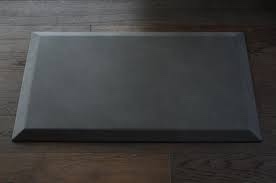Many recent studies have shown the prevalence of lower back pain, crediting it the number one cause of disability worldwide and one of the main reasons that people miss work. It’s so prevalent that it’s also the second most-common reason that patients go to the doctor. Lower back pain is certainly a frequent complaint that brings patients into Encore Physical Therapy too. If you are one of the nearly 50% of the population who suffers from occasional or chronic back pain, consider the products you use daily that could exacerbate your condition.
Office Chair 
If you work at a desk, your chair can be a major contributing factor to the health of your posture, spine, and lower back. Generally an office chair with strong lower lumbar support will encourage better posture than a straight back or curved-out chair. Make sure your chair is adjustable so that your feet can touch the ground without raising your knees too high. Also consider replacing your chair with a yoga ball. With a little bit of practice the yoga ball will promote core strength while reducing compression on your lower spine.
Standing Station

Another option is to ditch the office chair all together. Standing stations allow you to remain in a standing position while you type, answer the phone, and look up data on the computer. This reduces the amount of compression and also provides an opportunity for more movement than while in a seated position. For a combination of sitting and standing, look for desktop computer risers or entire desks that raise and lower with the press of a button.
Anti-fatigue Mats
If you decide to replace your office chair with a standing station, be sure to include an anti-fatigue mat to stand on. You might also invest in anti-fatigue mats in front of the kitchen sink, stove, or anywhere else you spend large quantities of time standing.
Back/S.I. Braces
If your lower back issue is caused by weak muscles or injury, temporarily using a brace to stabilize the area can be helpful. Wearing a back or sacroiliac brace takes some of the pressure off of your lower back muscles. This can allow them to rest if needed. It can also allow them to strengthen via your recommended physical therapy techniques while reducing the risk of further back injury in the process.
Mattresses and Sleep Position
 Make sure to find the best mattress for your sleep style. If you’re not in the market for a new mattress, at least consider altering your sleep position. Most physical health experts agree the the most supportive sleep position for the lower back is on your side with a pillow between your knees. This helps keep your spine in alignment during the one-third of the day that you are not upright. Also consider pulling your knees into a fetal position. This offers a stretch to your spine and helps expand spacing between the vertebrates. If you’re not comfortable as a side-sleeper though, we recommend you lay on your back. Stomach sleeping is not recommended for back health, but if that’s your natural position, try placing a small pillow under your hips to lift the pelvis and avoid sagging the spine.
Make sure to find the best mattress for your sleep style. If you’re not in the market for a new mattress, at least consider altering your sleep position. Most physical health experts agree the the most supportive sleep position for the lower back is on your side with a pillow between your knees. This helps keep your spine in alignment during the one-third of the day that you are not upright. Also consider pulling your knees into a fetal position. This offers a stretch to your spine and helps expand spacing between the vertebrates. If you’re not comfortable as a side-sleeper though, we recommend you lay on your back. Stomach sleeping is not recommended for back health, but if that’s your natural position, try placing a small pillow under your hips to lift the pelvis and avoid sagging the spine.
Pillow
If you deal with back pain, you know that a seemingly unrelated area of the body can often contribute to the pain. Upper back and neck issues can radiate pain to your lower back, so choosing the right pillow based on your preferred sleeping position is worth the investment.
There are thousands of products on the market to help with lower back pain and many of them can alleviate symptoms. However, you may be able to minimize the need to treat back pain if you can keep it from occurring in the first place. This can be done through a combination of physical therapy strategies and products targeted towards supporting your needs. When deciding on the best products for your work, home, and physical situation, be sure to enlist the advice of your professional physical therapist.
